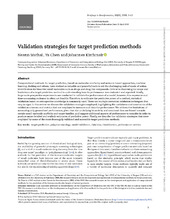| dc.contributor.author | Mathai, Neann Sarah | |
| dc.contributor.author | Chen, Ya | |
| dc.contributor.author | Kirchmair, Johannes | |
| dc.date.accessioned | 2020-04-15T12:20:21Z | |
| dc.date.available | 2020-04-15T12:20:21Z | |
| dc.date.issued | 2020 | |
| dc.Published | Mathai N, Chen Y, Kirchmair J. Validation strategies for target prediction methods. Briefings in Bioinformatics. 2020, 21 (3), 791–802. | eng |
| dc.identifier.issn | 1467-5463 | en_US |
| dc.identifier.issn | 1477-4054 | en_US |
| dc.identifier.uri | https://hdl.handle.net/1956/21871 | |
| dc.description.abstract | Computational methods for target prediction, based on molecular similarity and network-based approaches, machine learning, docking and others, have evolved as valuable and powerful tools to aid the challenging task of mode of action identification for bioactive small molecules such as drugs and drug-like compounds. Critical to discerning the scope and limitations of a target prediction method is understanding how its performance was evaluated and reported. Ideally, large-scale prospective experiments are conducted to validate the performance of a model; however, this expensive and time-consuming endeavor is often not feasible. Therefore, to estimate the predictive power of a method, statistical validation based on retrospective knowledge is commonly used. There are multiple statistical validation techniques that vary in rigor. In this review we discuss the validation strategies employed, highlighting the usefulness and constraints of the validation schemes and metrics that are employed to measure and describe performance. We address the limitations of measuring only generalized performance, given that the underlying bioactivity and structural data are biased towards certain small-molecule scaffolds and target families, and suggest additional aspects of performance to consider in order to produce more detailed and realistic estimates of predictive power. Finally, we describe the validation strategies that were employed by some of the most thoroughly validated and accessible target prediction methods. | en_US |
| dc.language.iso | eng | eng |
| dc.publisher | Oxford University Press | en_US |
| dc.rights | Attribution CC BY | eng |
| dc.rights.uri | http://creativecommons.org/licenses/by/4.0/ | eng |
| dc.subject | target prediction | eng |
| dc.subject | polypharmacology | eng |
| dc.subject | model validation | eng |
| dc.subject | data bias | eng |
| dc.subject | Classification | eng |
| dc.subject | performance metrics | eng |
| dc.title | Validation strategies for target prediction methods | en_US |
| dc.type | Peer reviewed | |
| dc.type | Journal article | |
| dc.date.updated | 2020-02-11T08:40:38Z | |
| dc.description.version | publishedVersion | en_US |
| dc.rights.holder | Copyright 2019 The Author(s) | en_US |
| dc.identifier.doi | https://doi.org/10.1093/bib/bbz026 | |
| dc.identifier.cristin | 1748211 | |
| dc.source.journal | Briefings in Bioinformatics | |
| dc.source.pagenumber | 791–802 | |
| dc.identifier.citation | Briefings in Bioinformatics. 2020, 21 (3), 791–802. | |
| dc.source.volume | 21 | |
| dc.source.issue | 3 | |

